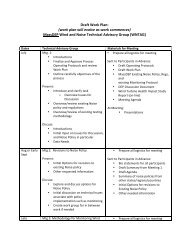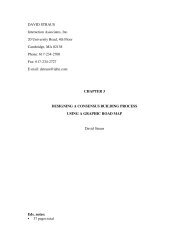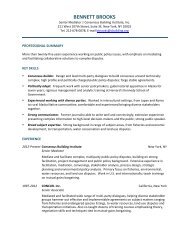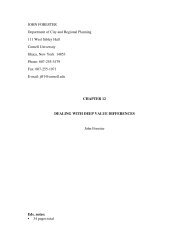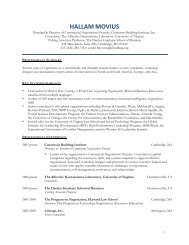Vegetated Geogrids
Vegetated Geogrids
Vegetated Geogrids
Create successful ePaper yourself
Turn your PDF publications into a flip-book with our unique Google optimized e-Paper software.
Materials used to construct a live fascinebank stabilization project include: livebranch cuttings, live pegs, dead stakes,mulch materials, twine, and backfill.Construction typically involvespreparation of the live fascines andstakes prior to the commencement of thesite work. Site work will typicallyinvolve the excavation of one foot wideby one foot deep trenches along theslope beginning at the base. A series oftrenches will be excavated in rows alongthe entire bank. Long straw and/orannual grass can be planted between therows for further erosion prevention. Thebottom of the trenches should be layeredwith a geo-membrane or other erosioncontrol fabric. The fascines are thenplaced in the trench, with live stakesplaced on the downslope side of eachfascine and dead stakes driven directlythrough the fascine.The cost associated with a live fascineproject is low-moderately expensivewhen compared to other engineeredshore protection approaches. Materialcosts are generally low; however theapproach is fairly labor intensive.Once installed live fascines provideimmediate protection to the shore.Eighty percent of the live fascines mustsurvive for the project to be successful.The site should be examined after thefirst few floods or at least twice a year toensure the project is performing up toexpectations. The required maintenancewill depend on stream velocity, floodfrequency, and other parameters. Anyidentified flanking or undercuttingshould be repaired immediately toensure the continued stability of theproject.AdaptabilityLive fascines are adaptable from thestandpoint that they can always beextended up or down an existing slope toaccommodate fluctuating water levels.Dealing with die off at the toe of thestructure and possibly the associatedundermining and slumping howevercould prove difficult and costly. Livefascines also have a limited tolerance towaves and currents, so any increase ineither could damage an existinginstallation.AdvantagesLive fascines have many advantagesover other engineered shore protectionapproaches, among them are:• The approach does not cause a largeamount of site disturbance.• Once they are installed they provideimmediate protection.• Fascines trap soil and facilitatedrainage on the slope.• Fascines can enhance conditions forvegetation growth.• They retain a natural appearance andare typically considered aestheticallypleasing.DRAFTDisadvantagesLive fascines have many disadvantagescompared to other engineered shoreprotection approaches, among them are:• They are only effective on mildlysloping shallow shorelines.• They are only effective for smallerstreams.




